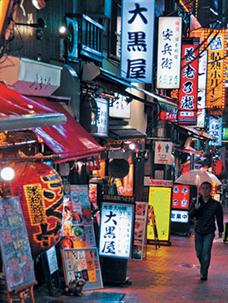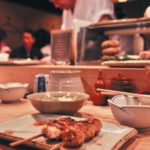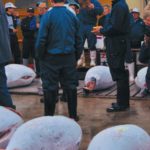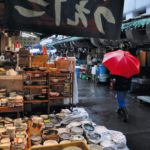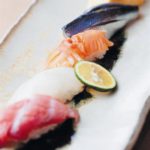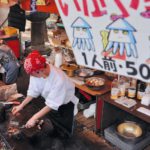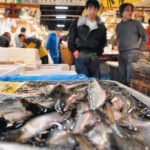Regular contributor Richard Holmes went big in Japan.
Kappabashi Street was my last stop in Japan, after a week of eating my way across the capital of the ‘land of the rising sun’. The old eastern suburbs of Tokyo are the heart of the city’s restaurant trade. Not that you’ll find much to eat here; it’s chefs, not diners, who flock to Kappabashi to stock up. Need chopsticks? Perhaps a plastic replica of a bowl of ramen noodles? What about knives, woks and steamers? You’ll find them all on Kappabashi, along with my favourite: a shop selling only plastic mannequins for greeting diners at the door. Whether you fancy a T-Rex, a smiling cow or a portly Italian, Kappabashi can provide.
It’s a massive city, so my first dilemma was where to start. The answer, as always, is to ask a local. And for me that local was Shinji Nohara, a gourmet guide and writer who has helped the likes of Anthony Bourdain decide where to eat. “For Japanese people, ramen is the flavour that reminds them of home. You simply cannot get good ramen outside of Japan,” says Shinji. Kaduya, an eatery in the suburb of Meguro, is one of Shinji’s favourite ramen bars, where a bowl of soup, noodles and dumplings cost less than ¥1 000 (R100).
“Traditionally, ramen soup is a mixture of vegetable and chicken broth, but this chef blends in a broth of dried fish too,” explains Shinji, slurping away (as is polite in Japan). “It looks like a simple dish, but the flavours are very complex. “Tokyo is full of tiny restaurants like this, serving just a few people at a time,” says Shinji. “Why do these small restaurants survive? Because they keep things simple… they are specialists, they use the best ingredients, and the locals know that the few dishes they serve, they do well.”
And perhaps nowhere is produce more respected than in Tokyo’s sushi bars. Even Tsukiji Sushiko – the unfussy sushi bar I find myself in one night – is impressive in its simplicity. Nigiri or sashimi, that’s it. A simple choice, but the array of produce involved is startling: snow crab, horse mackerel, salmon roe, clams, scallops and – of course – the fatty toro tuna belly that is sushi’s holy grail. But if sushi is Japanese simplicity on a plate, then kaiseki is its complicated cousin.
That evening I smarten up and ring the bell at the glamorous Shangri-La hotel. On the 29th floor, the fine-dining restaurant Nadaman gazes out over the skyscrapers of Marunouchi, Tokyo’s business district. A few businessmen perch at the sushi bar, but I’m here to settle in; ahead of me stretches a multi-course feast. Western degustation menus trace their roots to the Japanese tradition of kaiseki, which is all about attention to detail: delicate plating, bespoke crockery and a balance of flavour and textures. “Kaiseki should always reflect the seasons,” explains Minako Hayata, my host at Shangri-La. “The meal is a work of art, and it’s important there is harmony between the dish and the plate that it’s served on.”
Nadaman’s modern Japanese cuisine doesn’t disappoint. Sushi of sea eel leads into a sublime goose liver in egg custard. Simmered cod with grated radish – daikon is often served, as it’s said to aid digestion – and a grilled clam with nori butter sauce make up the bulk of the eight-course menu.
But, as I wander back to my hotel through the Ginza upmarket shopping district, I stumble across a place that occupies the other end of the fine-dining spectrum. Izakaya are bars that serve food and under the railway arches of Yurakucho station is one of the city’s most famous: Andy’s Shin Hinomoto. It’s a no-frills place where the beer and wine flow freely, but the menu offers good cut-price cooking. A whole salt-grilled squid will cost just ¥700 (R70), while tempura for two is ¥1 600 (R160).
From boisterous bars to the pageantry of kaiseki, eating out in Tokyo is simply a matter of peeling back the layers. Beneath the railway tracks there is fine food for a handful of yen, or you could pay thousands for a cocktail in the city’s skyrise hotels. I did both and enjoyed them equally. If there’s a regret it’s that I was never – not once – greeted at the door by a T-Rex. Maybe next time…
www.tokyofixer.com: for food tours with competent guide, Shinji Nohara
www.jnto.go.jp: Japan National Tourist Organisation

